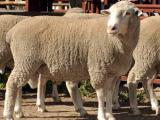
|
Afrino SheepDuring the late 1960's, a request was made to the Department of Agriculture by the wool industry, via the South African Agricultural Union, to develop a white-wooled breed for extensive sheep grazing areas. In 1976, it was evident that the crossing of 25 percent Merino, 25 percent Ronderib Afrikaner, and 50 percent South African Mutton Merino best fullfilled the requirements set for the new breed. |

|
Altay SheepThe Altay originated in the regions of China typified by dry, cold mountain basins. They belong to the Kazakh group of sheep which are found in the desert and mountainous areas in west Xinjiang. Altay belong to the fat-rumped, carpet wool type. They gradually formed the fat tail (or rump) as a biological characteristic. The tail (or rump) weighs about 15 pounds (7 kg). |

|
American Blackbelly SheepThe American Blackbelly is a composite breed resulting from the crossing of Barbados Blackbelly on the Mouflon and Rambouillet breeds. As the name implies, the underbelly of the American Blackbelly is black, as is the inside of the legs, the back part of the thighs, and the hair inside the ears. Two black facial barbs extend down the muzzle medial to the eye, giving the breed an exotic appearance. |

|
Apennine SheepThe Apennine breed was founded in the 1970's in central Italy, mainly in the Toscana, Emilia, Umbria, Arche, and Abruzzi regions of Italy; crossbreeding the local breed with other Italian or exotic breeds such as Bergamasca and Ile-de-France. It is a medium wool breed kept primarily for meat production. It is polled and has semi-lopped ears. |

|
Aragonesa SheepThe Rasa Aragonesa sheep is the second most important Spanish breed after the Merino breed. Spanish sheep breeds of medium quality wool are considered to have originated from the crossbreeding of fine-wool strains (Merino) and those with coarse wool (Churra and Lacha), though this viewpoint is overly simplistic. |

|
Arapawa SheepThe most probable origin for the Arapawa feral sheep is that they are escapees of a flock of mainly Merino origin, known to have been introduced in 1867, the original stock having undoubtedly come from Australia. It is possible that they were introduced earlier by whalers who were the first European occupants of the Island. They are considered a rare and endangered breed. Arapawas are rather prehistoric-looking wild sheep. |

|
Assaf SheepThe Assaf sheep is the result of crossbreeding the Awassi and East Friesian Milk sheep. In 1955, researchers of the Israeli Agricultural Research Organization (A.R.O) started this project aiming to improve the fecundity of the Awassi sheep. A combination of 3/8 East Friesian and 5/8 Awassi blood emerged as the best cross. |

|
Australian Merino SheepMore than 80 percent of all Australian sheep are pure Merino, with most of the remainder at least part Merino blood. Merino is grown primarily for its heavy fleeces of fine wool. Although the Australian Merino derives its name and basic appearance from the Spanish breed, it is a distinct breed in its own right, developed and adapted in Australia to the specific conditions of this country. Merino sheep were brought to Australia from the Cape Colony, England, Saxony (South East Germany), France, and America. The Australian Merino is not a single homogenous breed but a number of strains of sheep all of which, regardless of their origins, are uniquely Australian. The major factor determining the Merino’s development has been the requirement for environmental suitability. |

|
Avranchin SheepThe Avranchin is a grassland breed, hardy and well adapted to the ocean climate, usually living outdoors in small flocks. It is one of the most prolific French breeds. With a large or medium-sized frame, it produces lambs of good butchering quality, with very fine textured meat. |

|
Awassi SheepThe Awassi evolved as a nomadic sheep breed through centuries of natural and selective breeding to become the highest milk producing breed in the Middle East. The breed is of the Near Eastern fat-tailed type. The average Awassi ewe has single lactations over 300 liters (650 pounds) per 210-day lactation, and it is not uncommon for outstanding females to have 210 day lactations above 750 liters (1,625 lbs). |